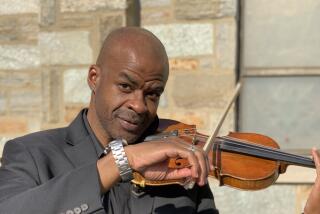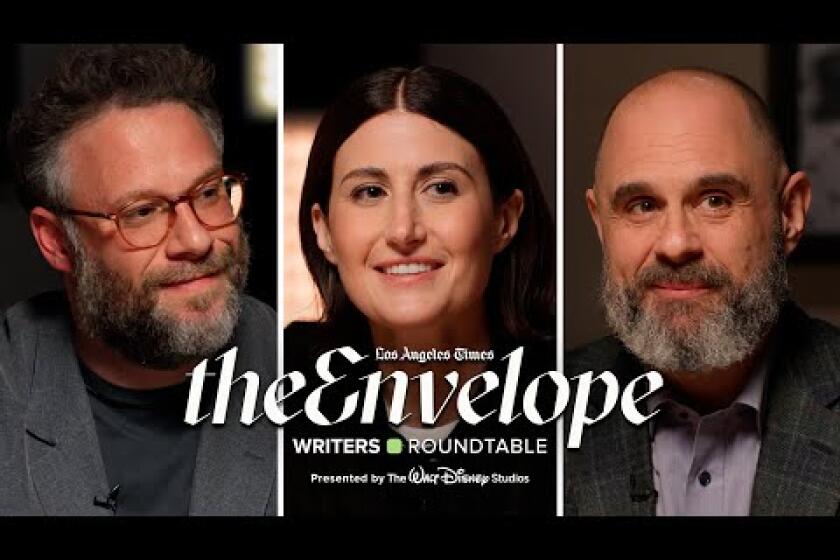JAZZ REVIEW : Violinist Explores Traditional Passages of India : L. Subramaniam speaks volumes about the roots and influences of his music in lecture, performance at UCI.
- Share via
IRVINE — It’s common to hear about a musician who is exploring his roots. In the case of India-born violinist L. Subramaniam, those roots run deeper than most.
Subramaniam has made a name in this country fusing the traditions of Indian classical music with Western classical tradition as well as with jazz and rock styles. He’s played with Yehudi Menuhin and Stephane Grappelli, jammed with George Harrison and improvised with fusionists including saxophonist Tom Scott and keyboardist George Duke. He’s also recorded with such Indian masters as Ali Akbar Kahn and Ravi Shankar. His own recordings include the five-volume “Anthology of Indian Music.”
On Wednesday, Subramaniam was at the Crystal Cove Auditorium on the UC Irvine campus giving a lecture and demonstration sponsored by the Society for the Promotion of Indian Classical Music and Culture Amongst Youth. The presentation shed light on just how deeply the violinist’s roots are anchored in the musical history of his native land, a history that stretches back 2,000 years to Vedic times.
Subramaniam opened the program by discussing the northern and southern musical traditions of his country and the various influences that have contributed to them. His brief discussion of the carnatic (southern) tradition--Subramaniam was born in Madras--outlined the forms the music takes (ragas) , the 72 scales ( regags ) the music is built on, its rhythmic basis ( tala ) and the role of improvisation during the performance.
Although much of the explanation of the music’s mathematical foundations may have been lost on the casual listener (muddy reproduction of Subramaniam’s voice didn’t help), the spirit and beauty of the music was apparent as soon as the violinist began to play.
Working with mridangam player M.R. Ganesh, surbahaar player Subha Krishnan and an electronic box that provided an uninterrupted five-tone drone (tanpura), Subramaniam developed a piece from the kriti format, religious-inspired music constructed of three sections.
His introduction ( aalapanai ) developed slowly, outlining the melodic form the piece was to take. The rhythmic element, added by Ganesh on the mridangam --a barrel-shaped, two-headed drum played in a horizontal position whose sound closely resembles its northern counterpart, the tabla --freed Subramaniam to develop his melodic ideas.
The two exchanged phrases or sometimes played in unison, with Ganesh working a wide array of tones from the drum. Krishnan’s surbahaar , a lap-held, stringed instrument in the shape of a rectangular box, produced such delicate sounds that it disappeared behind the violin and mridangam.
As is common in Indian music, Subramaniam’s phrases, full of sliding notes and various tonal shades, built in complexity and volume near the piece’s end.
In the second half of the performance, Ganesh, accompanied only by the drone, wove together a percussive display that was notable for both its rhythmic and tonal variations. Then, in tandem with Subramaniam, he worked flourishes and double-times against the violinist’s cries and moans. The impassioned exchange brought light to Subramaniam’s earlier statement of the importance of “bringing the feeling and the emotion of the raga to what we play.”
It was easy during the performance to make connections between the circular, theme-improvisation format of classical Indian music to that of American jazz, and to associate the polyrhythmic tempos found in both styles. And perhaps that was the evening’s most prominent lesson: Music is indeed a universal language.
More to Read
The biggest entertainment stories
Get our big stories about Hollywood, film, television, music, arts, culture and more right in your inbox as soon as they publish.
You may occasionally receive promotional content from the Los Angeles Times.









